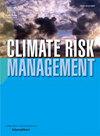Climate-smart aquaculture practice: Changes in economic viability and efficiency of mud crab fattening in coastal Bangladesh
IF 5
2区 环境科学与生态学
Q1 ENVIRONMENTAL SCIENCES
引用次数: 0
Abstract
Crab fattening has been flourishing along the coastal regions of South Asian countries, including Bangladesh, offering significant livelihood opportunities for local dwellers, yet its economic viability remains underexplored. This study evaluates the economic viability (profitability and risk), determinants of crab production, technical efficiency, and factors contributing to inefficiency among crab fatteners in coastal Bangladesh, utilizing panel data from 2018 and 2023, for the first time. Fixed-effects regression was employed to identify the drivers of crab production, while a true random-effects Cobb-Douglas panel stochastic frontier model was used to estimate technical efficiency. The profitability of crab fattening declined from USD 3,978 per hectare in 2018 to USD 3,351 per hectare in 2023. Despite this decline, both crab production and prices increased over time, mitigating the risk of losses and ultimately enhancing economic viability. Factors positively influencing production included age, education, income, access to credit, proximity to output markets, crab price, crablet stocking, feed, and water exchange, whereas disease prevalence had a negative impact. The mean technical efficiency of crab fatteners improved from 0.69 in 2018 to 0.74 in 2023. Education, income, crab price, and market proximity positively influenced technical efficiency, while distance to extension offices and disease prevalence negatively impacted it. Enhanced extension support, improved access to credit, fair market pricing, and the development of hatcheries for quality crablet could bolster the success of this climate-smart aquaculture practice, aiding Bangladesh in achieving Sustainable Development Goal 2.3 of doubling the agricultural productivity and income of small-scale farmers.
气候智能型水产养殖实践:孟加拉国沿海地区泥蟹养殖经济可行性和效率的变化
在包括孟加拉国在内的南亚国家的沿海地区,螃蟹养殖一直在蓬勃发展,为当地居民提供了重要的生计机会,但其经济可行性仍未得到充分探索。本研究首次利用2018年和2023年的面板数据,评估了孟加拉国沿海地区螃蟹养殖者的经济可行性(盈利能力和风险)、螃蟹生产的决定因素、技术效率以及导致效率低下的因素。采用固定效应回归识别螃蟹生产驱动因素,采用真正随机效应的Cobb-Douglas面板随机前沿模型估计技术效率。螃蟹养殖的盈利能力从2018年的每公顷3978美元下降到2023年的每公顷3351美元。尽管产量下降,但随着时间的推移,螃蟹产量和价格都有所增加,减少了损失的风险,最终提高了经济可行性。对产量产生积极影响的因素包括年龄、教育程度、收入、获得信贷的机会、靠近产出市场、螃蟹价格、螃蟹放养、饲料和水交换,而疾病流行对产量产生负面影响。螃蟹育肥者的平均技术效率从2018年的0.69提高到2023年的0.74。教育程度、收入、螃蟹价格和市场接近程度对技术效率有正向影响,而与推广办事处的距离和疾病流行程度有负向影响。加强推广支持、改善获得信贷的机会、公平的市场定价以及开发优质螃蟹的孵化基地,可推动这种气候智能型水产养殖做法取得成功,帮助孟加拉国实现可持续发展目标2.3,即使小农的农业生产力和收入翻一番。
本文章由计算机程序翻译,如有差异,请以英文原文为准。
求助全文
约1分钟内获得全文
求助全文
来源期刊

Climate Risk Management
Earth and Planetary Sciences-Atmospheric Science
CiteScore
8.20
自引率
4.50%
发文量
76
审稿时长
30 weeks
期刊介绍:
Climate Risk Management publishes original scientific contributions, state-of-the-art reviews and reports of practical experience on the use of knowledge and information regarding the consequences of climate variability and climate change in decision and policy making on climate change responses from the near- to long-term.
The concept of climate risk management refers to activities and methods that are used by individuals, organizations, and institutions to facilitate climate-resilient decision-making. Its objective is to promote sustainable development by maximizing the beneficial impacts of climate change responses and minimizing negative impacts across the full spectrum of geographies and sectors that are potentially affected by the changing climate.
 求助内容:
求助内容: 应助结果提醒方式:
应助结果提醒方式:


